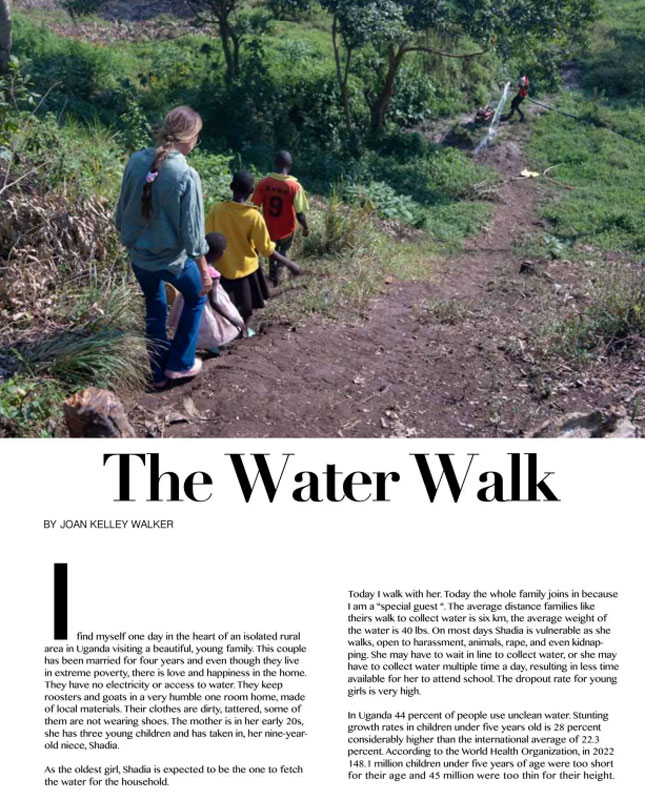29 Jan The Water Walk
Posted at 07:12h
in
Living Luxe,
Writing
by admin
I find myself one day in the heart of an isolated rural area in Uganda visiting a beautiful, young family. This couple has been married for four years and even though they live in extreme poverty, there is love and happiness in the home. They have no electricity or access to water. They keep roosters and goats in a very humble one-room home, made of local materials. Their clothes are dirty, and tattered, and some of them are not wearing shoes. The mother is in her early 20s, has three young children, and has taken in, her nine-year-old niece, Shadia.
As the oldest girl, Shadia is expected to fetch the water for the household. Today I walk with her. Today the whole family joins in because I am a “special guest”. The average distance families like theirs walk to collect water is six km, the average weight of the water is 40 lbs. On most days Shadia is vulnerable as she walks, open to harassment, animals, rape, and even kidnap ping. She may have to wait in line to collect water, or she may have to collect water multiple times a day, resulting in less time available for her to attend school. The dropout rate for young girls is very high.
In Uganda, 44 percent of people use unclean water. Stunting growth rates in children under five years old is 28 percent considerably higher than the international average of 22.3 percent. According to the World Health Organization, in 2022 148.1 million children under five years of age were too short for their age, and 45 million were too thin for their height. It doesn’t stop there. On top of malnutrition, there is a myriad of other problems that unsafe water can lead to. Contamination- ed water and poor water quality are linked to the transmission of many diseases such as, cholera, diarrhea, hepatitis A, typhoid, and polio. According to the WHO, about one million people are estimated to die each year from diarrhea as a result of unsafe drinking water.
As our group walks towards the water hole, I am enjoying myself. It is nice to see the scenery, chat with the family, and hold the hands of the little ones but my heart stops once we reach the bore-hole. It is at the bottom of a steep, slippery hill with no path, stairs, or rail. It is extremely dangerous and to make it even worse, it is explained to me that if animals are drinking from this hole, you have to wait for the animals to finish, then you have to wait for the water to “settle” before trying to collect the water. Fortunately, there are no animals today but I am shocked at how the water is murky and a dark gray color. You cannot see the bottom and I have no idea how deep it is. It is filled with silt, dirt, and bugs… I wonder, what else? The act of collecting the water is very awkward because you step on a slimy algae-covered log to be able to reach it. One could easily slip in an unstable environment. We use a smaller container to fill the larger containers. The smaller container has black mold on it. We finish filling all the containers we have brought and set out for home.
The impact of how steep the hills and how long the walk is hits me. The hill is treacherous, it is scary, dangerous, and even slippery – at one point I fall to my knee. The father shared with me that recently an older man went to fetch his water at this hole. After he collected the water he needed, he struggled to get up the hill and fell backward back down. He lost his life that day. The impact and the danger of the simple act of fetching water is profound. Many times while walking home, I had to stop to catch my breath because the container was so heavy, I had to constantly check my footing. This family’s reality to get water is a treacherous journey filled with bugs, heavy containers that are awkward to carry, not to mention the uneven dense terrain, and dangerous pitch. There were bugs, the containers were heavy and awkward to carry, not to mention the uneven dense terrain and the dangerous pitch.
On one hand I am filled with the deepest gratitude for the easy access that my family enjoys for safe and clean water in my own home, something most of us take for granted. On the other hand, I am in awe of Shadia and all that she faces. Water is the essence of life on earth, a vital resource. Yet, this is Shadia’s and many others’ reality. According to World Vision, the number of people lacking access to clean water has fallen from 1.1 billion in 2000 to 703 million in 2022 but challenges remain and water scarcity is one of the critical issues in the world today. So what is to be done?
Joan Kelley Walker is a TV personality and star of The Real Housewives of Toronto, as well as an avid supporter of youth by being an ambassador for World Vision and having sat as chair of United Way York Region’s Women’s Leadership Council.





